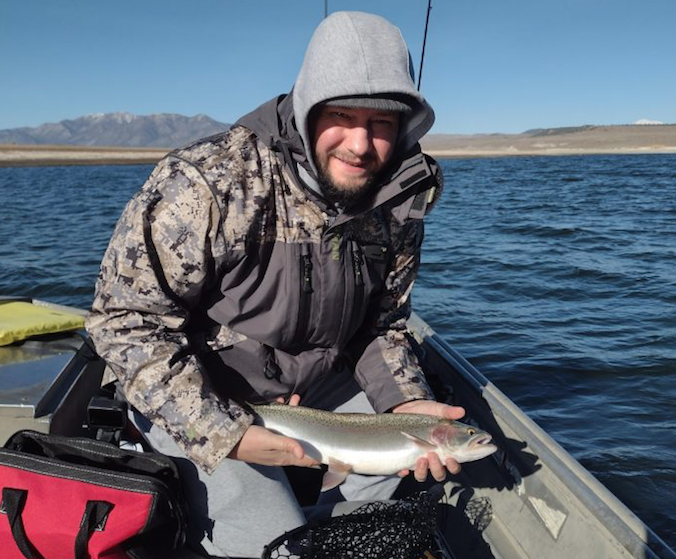BY CHUCK WOLF
CROWLEY LAKE– Lake Crowley boasts one of the most prolific trout fisheries on the eastern side of the Sierras. Formed in 1941 after a dam was built on the upper Owens River, the lake now serves as a major source of water for Southern California, and particularly Los Angeles. Elevation, feed and fishery management have all contributed to the lakes success making this a go-to destination for anglers seeking Sacramento perch, cutthroat, rainbow and brown trout.
Easy access makes it a great destination for shoreside anglers and fly fishermen casting midges under a bobber from shore, a boat or a tube do exceptionally well in the Fall. But overall, trolling leadcore line to reach suspended fish in almost any depth of water, has proven itself time and time again to be one of the most consistent fish producing techniques during almost any season.
I had a recent opportunity to fish Lake Crowley with Dave Clay a seasoned Lake Crowley veteran and a die-hard lead line fisherman and old school or not, Clay catches fish!
Clay uses 6- to 8-foot rods with a medium action. Leadcore line is thicker and heavier than mono, and the usual trout noodle just won’t handle the added weight, drag and a fish. There is no need to gear up with anything expensive and most standard-level wind reels will work. Because lead line tends to bind up on one side of the reel or the other, the level wind helps ensure a consistent distribution of line across the spool.

Sufix, Tuf-Line and PowerPro all have varieties of lead core line and a 100-yard spool of 15-pound line will generally cost about twenty dollars. Add braid backing to give you depth control plus the added assurance that a big fish won’t spool you.
Buy color color-coded line. Each color segment is usually about 10 yards long, allowing you to set your lures at a particular depth without the need of a line counter. Generally, 1 length of color equals about 5 feet of sink. For example, a lure trolled behind the boat at a speed of 1.5-2 mph with a setback length of three colors will run at about 15 feet of depth, 4 colors about 20 feet and so on. Clay uses short monofilament leaders with a swivel attached to the working end of the lead line and another snap swivel attached from the monofilament to the lure. The shorter leaders tend to keep the baits at a depth that is closer to the color set. Because lead line is thicker than braid, most anglers remove about 4 inches of the core and tie their swivels on with a standard clinch knot. You can tie monofilament directly to your working line with an Alberto knot. Use a lighter leader weight than your lead core, that way if you do snag, all you lose is your lure and not your more expensive line.
Lure selection can include just about anything in your box, but some lures will run deeper or shallower than your color code. Large bill crank bait will run deeper than your color code might indicate. In line flashers add more drag and may raise your baits. If you think that you are above the fish, or in deeper water, let out more line to sink should into the zone. If you’re below the fish, or in shallow water, take in some line or increase your trolling speed, to raise your baits. When setting your lines, make sure that the boat is moving. Leadcore line sinks fast and if you’re not moving, you’re likely to get snagged. The same thing can happen on turns when the inside bait slows. It’s also an easy mix when trolling surface baits with braid or monofilament.
We spent the day trolling the seasonal hot spots including Chalk Cliffs, Alligator Point, Green Banks and McGee Bay. We trolled an inline Luhr Jensen “School-O-Minnows” flasher and Tequilla Sunrise Tasmanian Devil on a three-foot leader set behind the flasher. We mixed it up on the other rod with 4-inch Rapalas, Mepps dressed spinners, Mepps Long Gold spinners and Thomas Buoyant spoons on 6-foot leaders without a flasher. Each of the baits produced but the Tas outperformed them all producing a Crowley Lake “Grand Slam” a Sacramento perch, a cutthroat, brown and rainbow trout.
Leadcore line fishing might be old school to some, but it is a time proven technique for taking trout and is rapidly re-gaining popularity with anglers seeking an easy setup that works on a variety of species.




